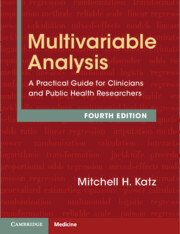Book contents
- Multivariable Analysis
- Multivariable Analysis
- Copyright page
- Contents
- Preface
- 1 Introduction
- 2 Common Uses of Multivariable Models
- 3 Outcome Variables in Multivariable Analysis
- 4 Independent Variables in Multivariable Analysis
- 5 Relationship of Independent Variables to One Another
- 6 Setting Up a Multivariable Analysis
- 7 Performing the Analysis
- 8 Interpreting the Results
- 9 Delving Deeper: Checking the Underlying Assumptions of the Analysis
- 10 Propensity Scores
- 11 Correlated Observations
- 12 Sensitivity Analysis
- 13 Validation of Models
- 14 Special Topics
- 15 Publishing Your Study
- 16 Summary: Steps for Constructing a Multivariable Model
- Index
12 - Sensitivity Analysis
Published online by Cambridge University Press: 09 October 2025
- Multivariable Analysis
- Multivariable Analysis
- Copyright page
- Contents
- Preface
- 1 Introduction
- 2 Common Uses of Multivariable Models
- 3 Outcome Variables in Multivariable Analysis
- 4 Independent Variables in Multivariable Analysis
- 5 Relationship of Independent Variables to One Another
- 6 Setting Up a Multivariable Analysis
- 7 Performing the Analysis
- 8 Interpreting the Results
- 9 Delving Deeper: Checking the Underlying Assumptions of the Analysis
- 10 Propensity Scores
- 11 Correlated Observations
- 12 Sensitivity Analysis
- 13 Validation of Models
- 14 Special Topics
- 15 Publishing Your Study
- 16 Summary: Steps for Constructing a Multivariable Model
- Index
Summary
Sensitivity analysis tests how robust the results are to changes in the underlying assumptions of your analysis. In other words, if you made plausible changes in your assumptions, would you still draw the same conclusions? The changes could be a more restrictive or inclusive sample, a different way to measure your variables, a different way for handling missing data, or a change of a different feature of your analysis. With sensitivity analysis you cannot lose. If you vary the assumptions of your analysis and you get the same result, you will have more confidence in the conclusions of your study. Conversely, if plausible changes in your assumptions lead to a different conclusion, you will have learned something important. A common assumption tested in sensitivity analysis is that there are no unmeasured confounders, which can be tested with E values or falsification analysis. Other common assumptions tested are that losses to follow-up are random, that the sample is unbiased, that there is the correct exposure period and follow-up period, that there is a biased predictor or outcome, or that the model is misspecified.
Keywords
Information
- Type
- Chapter
- Information
- Multivariable AnalysisA Practical Guide for Clinicians and Public Health Researchers, pp. 225 - 237Publisher: Cambridge University PressPrint publication year: 2025
Accessibility standard: Inaccessible, or known limited accessibility
Why this information is here
This section outlines the accessibility features of this content - including support for screen readers, full keyboard navigation and high-contrast display options. This may not be relevant for you.Accessibility Information
Content Navigation
Allows you to navigate directly to chapters, sections, or non‐text items through a linked table of contents, reducing the need for extensive scrolling.
Provides an interactive index, letting you go straight to where a term or subject appears in the text without manual searching.
Reading Order & Textual Equivalents
You will encounter all content (including footnotes, captions, etc.) in a clear, sequential flow, making it easier to follow with assistive tools like screen readers.
You get more than just short alt text: you have comprehensive text equivalents, transcripts, captions, or audio descriptions for substantial non‐text content, which is especially helpful for complex visuals or multimedia.
You can access graphs or charts in a text or tabular format, so you are not excluded if you cannot process visual displays.
Visual Accessibility
You will still understand key ideas or prompts without relying solely on colour, which is especially helpful if you have colour vision deficiencies.
You benefit from high‐contrast text, which improves legibility if you have low vision or if you are reading in less‐than‐ideal lighting conditions.
